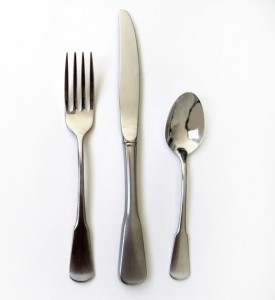When you are greeted at the front door by an excellent hostess, you sit at your favorite table, and then before you look at the menu, you notice your silverware is dirty.
Nothing should turn your spidey senses off more unless you went to the restroom and saw a whole toilet overflowing.
Please understand recent studies have shown that patrons who notice dirty silverware will frequently never return for another visit.
People ask me all the time why restaurants end up with dirty utensils, and it comes down to this:
Reasons For Dirty Silverware In A Restaurant or Club
- Restaurant owners are not following the manufacturer’s recommendations for their silverware presoak. Some are enzyme-based, and if used in hot water, you end up with pretty blue water since the enzymes never come to life.
- Facilities were trying to go cheap and use off-brand pot and pan soap instead. Nothing affects a dish machine more than adding some bubbles when the silverware passes through. Pot and Pan Detergent should never be near a dish machine to avoid accidental mixing.
- Not allowing the silverware to sit for an adequate amount of time in the presoak which allows the chemical to loosen up the different food soils with its wetting agents.
- The operators do not change the solution a sufficient number of times during a shift. If the dissolved presoak is cold, dirty, and greasy, it is time to change it. To be sure, look at the manufacturer’s recommendations or wall chart.
- My favorite pet peeve is soaking the silverware in a bus tub, however, having it so full that half of the silverware is out and not even in the solution or even getting wet.
Here are some recommendations after proper soaking
- The first silverware washing should be done on a flat rack only a couple of inches tall. I hate to tell you the times I have seen the silverware mounded in there, and the middle layer doesn’t even get wet.
- After that, silverware needs to be put in an upright type cylinder with the eating end exposed and put through the dishmachine next. After that is passed from one cylinder to the other, no one touches the eating end. Then, after being rewashed, allow it adequate time to dry.
- Have enough inventory of silverware on hand. If food service does not have enough silverware inventory, the dish machine operator is always pushed to cut short all proper procedures to get what they have done. This does not work and results in unclean utensils!!
Here is our summary
The proper handling of silverware is a process that has to be done correctly to give the customers a clean and sanitized utensil. Short cuts can leave the silverware either dirty or with a cloudy haze over it that is unappealing.
The handling of real silver will be a blog for another day. If I can help with any help, please reach out, and I can assist. Please look at our new website to see the latest items to arrive to help ChemStation Boston

